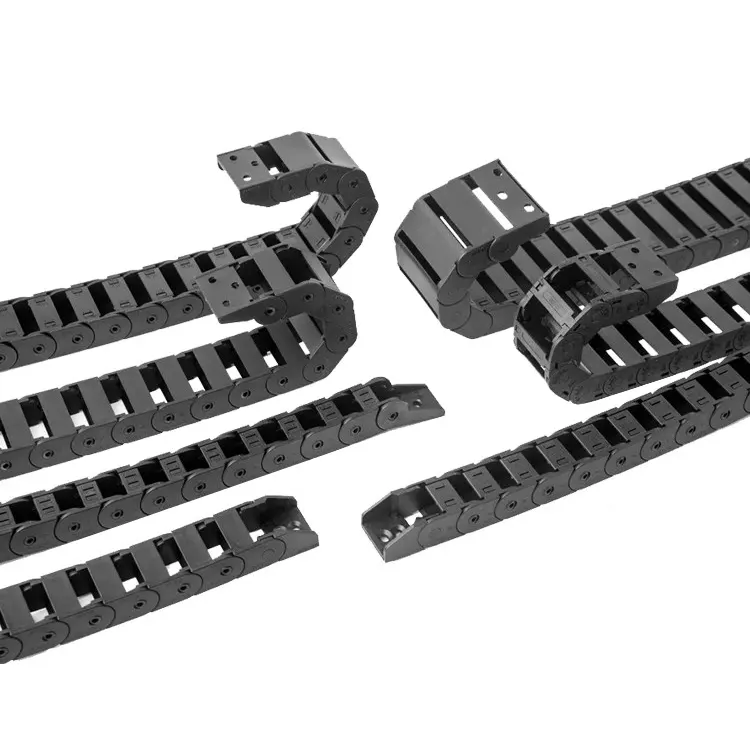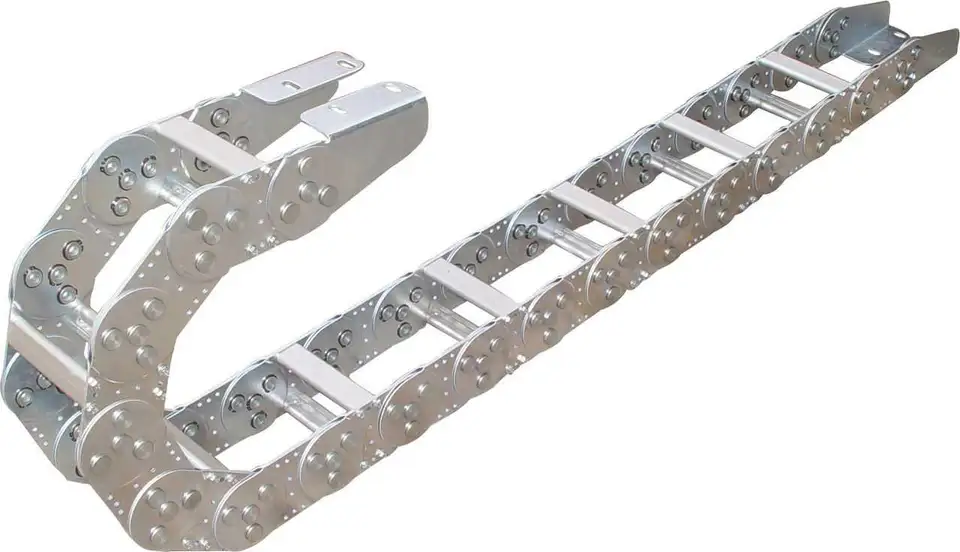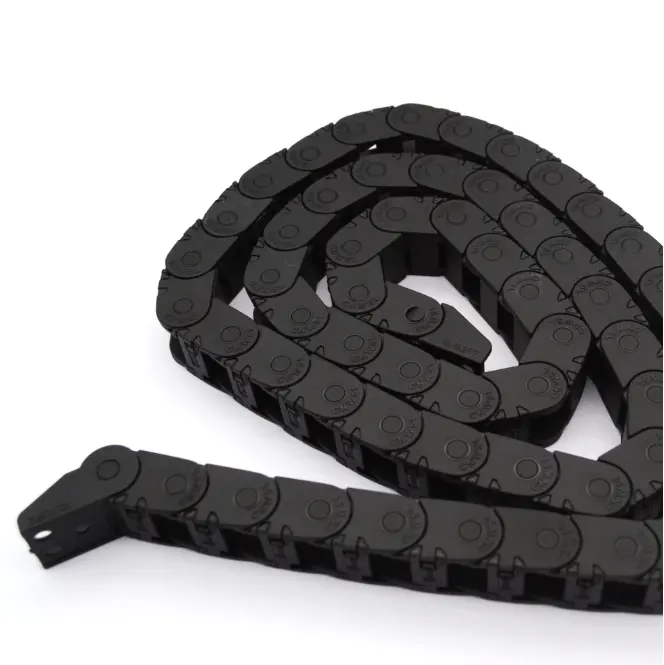Product Description
| Model | Effective width of machine slot(cm) | Yield(m³/H) |
| TGSS16 | 16 | 30 |
| TGSS20 | 20 | 55 |
| TGSS25 | 25 | 90 |
| TGSS32 | 32 | 130 |
| TGSS40 | 40 | 270 |
| TGSS50 | 50 | 400 |
The drag conveyor is made up with Machine head,machine body,machine tail,inlet and outlet.
(1) The machine head is made up with the main body box,drive sprocket,Gear box, transmission sprocket.Chain and drags.
(2) The tail is made up with main body box,sprocket,tensioning device.
(3) The intermediate body is made up with the tube ,slide rail chain & drags,machine cover etc.
(4) The inlet and outlet are made up with the flange and connecting joints used for input or discharge of the grain.
(5) Chain has T and V type,it is the main part of the conveyor for transportation of the grain.
(6)1t is a kind of gear box transmission ed through the chain and head shaft The drag chain conveyor is widely used in the port industry, grain warehouse,malt industry,brewery industry,feed mill company,oil factory and so on.
ZheJiang CHINAMFG Grain Steel Silo Company Ltd. is a leading supplier of grain storage solutions in China, dedicated to providing one-stop grain storage and supporting solutions for global customers.
The company was founded in 2007, and now has more than 30 invention patents and utility model patents, nearly 8,000 square CHINAMFG of dust-free workshop, equipped with the most advanced automatic laser cutting machine, CNC lathe, metal bending machine and automatic shearing The company has more than 10 professional designers and engineers, and hundreds of factory managers, workshop directors, production schedulers, skilled workers and installers.
1.who are you?
We are professional silo manufacturer and solution provider start from 2007 based in ZheJiang , China with 14 years experience in overseas trading.
2.how can you guarantee quality?
We have got CE, ISO9001certificates and many patents.
3.what can we buy from you?
Grain Silos, ventilation system, level sensor,silo intelligent cloud management system, weighing sensor system,sweep auger,temperature monitoring system,cooler,fumigation system for steel silo, electric control system, bucket elevator,drag conveyor, screw conveyor, belt conveyor,pneumatic conveyor, pre-cleaner, vibrating cleaner, pulse dust collector,cyclone,suction separator, magnetic drum.
4: I want to use our own brand , is it ok?
Of course it’s OK , we can make OEM products if your MOQ is 2 sets, and we can also can provide our own brand products
5:When you ship my order?
Normally 15-30 days after receiving your payment, but it can be negotiated based on order qty and production schedule.
6.what services can you provide?
Accepted Delivery Terms: FOB,CIF,EXW
Accepted Payment Currency:USD,CNY
Accepted Payment Type: T/T,L/C
Language Spoken:English,Chinese
7:How about the warranty ?
One year warranty .
/* January 22, 2571 19:08:37 */!function(){function s(e,r){var a,o={};try{e&&e.split(“,”).forEach(function(e,t){e&&(a=e.match(/(.*?):(.*)$/))&&1
| After-sales Service: | 24 Hours Online |
|---|---|
| Warranty: | One Year |
| Structure: | Conveyor System |
| Material: | Carbon Steel |
| Material Feature: | Oil Resistant, Heat Resistant, Fire Resistant |
| Application: | Grain Transport, Grain,Foodstuff,Oil,Feed Industries |
| Customization: |
Available
| Customized Request |
|---|

What are the temperature limits for drag chains in extreme environments?
Drag chains are designed to operate in a wide range of temperatures, but their temperature limits can vary depending on the materials used in their construction. In extreme environments, such as those with high or low temperatures, it is essential to select the appropriate drag chain that can withstand the specific conditions. Here are some general temperature guidelines for drag chains:
- Standard Drag Chains: Most standard drag chains can typically handle temperatures ranging from -40°C to 80°C (-40°F to 176°F). These are suitable for many industrial applications with moderate temperature variations.
- High-Temperature Drag Chains: For applications that involve higher temperatures, specialized high-temperature drag chains are available. These can handle temperatures up to 250°C (482°F) or even higher, depending on the materials used, making them suitable for use in hot environments like foundries or ovens.
- Low-Temperature Drag Chains: In cold environments, where temperatures can drop significantly below freezing, low-temperature drag chains are used. These can withstand temperatures as low as -50°C (-58°F) and are commonly used in freezer storage systems or cold storage facilities.
- Heat-Resistant Materials: Drag chains can be manufactured using various heat-resistant materials, such as stainless steel, special plastics, or composite materials, to withstand extreme temperature conditions without compromising their performance.
It is crucial to consult with the drag chain manufacturer or supplier to ensure that the selected drag chain is suitable for the specific temperature range of the environment in which it will be used. Using drag chains with appropriate temperature limits helps to maintain reliable cable protection and system performance even in extreme conditions.

Can drag chains be used in the energy and power generation sector?
Yes, drag chains are commonly used in the energy and power generation sector for cable management and protection. The energy and power generation industry includes power plants, renewable energy facilities, electrical substations, and other related applications. Here’s how drag chains are utilized in this sector:
- Cable Protection: The energy and power generation sector often involves a complex network of cables and hoses that carry electricity, signals, and fluids. Drag chains are used to protect these cables from damage caused by continuous motion, abrasion, and exposure to external elements.
- Dynamic Applications: In power generation facilities, various equipment such as turbines, generators, and transformers require dynamic cable management due to continuous movement. Drag chains can handle these dynamic applications, ensuring that cables and hoses remain organized and safely routed during equipment operation.
- Harsh Environments: Power plants and substations may expose cables to harsh environments, including extreme temperatures, chemicals, and outdoor conditions. Drag chains made from durable and corrosion-resistant materials can withstand these challenges, providing reliable cable protection and management.
- High Loads: Drag chains are capable of supporting multiple cables and hoses, even in applications with high loads and complex cable configurations. They prevent cables from tangling, getting caught, or suffering excessive stress during equipment operation.
- Long Travel Distances: In some power generation facilities, cables may need to travel long distances to connect different components and systems. Drag chains facilitate smooth movement over these long travel distances, ensuring that cables are managed efficiently and without interference.
- Enhanced Safety: Cable management is critical in the power generation sector to maintain a safe working environment. Drag chains keep cables organized, reducing the risk of accidents caused by cable entanglement or tripping hazards.
- Reliability and Longevity: Drag chains are designed for long service life and reliable performance, minimizing downtime and maintenance requirements. This is especially important in critical power generation applications where uninterrupted operation is essential.
Overall, drag chains play a crucial role in the energy and power generation sector by providing efficient cable management and protection. Their ability to handle continuous flexing, harsh environments, and dynamic applications makes them a valuable solution for ensuring the reliability and safety of cable systems in this industry.

How do drag chains prevent cable wear and ensure smooth cable movement?
Drag chains, also known as cable carriers or cable chains, play a crucial role in protecting cables and hoses while ensuring their smooth movement in industrial applications. Here’s how they achieve this:
1. Enclosed Design:
Drag chains have an enclosed design with a series of interconnected links that form a protective channel for the cables and hoses inside. This design prevents external elements like dust, debris, and liquids from coming into direct contact with the cables, reducing the risk of abrasion and wear.
2. Cable Separation:
The individual links in the drag chain keep the cables and hoses separated from each other, preventing them from getting tangled or rubbing against each other. This separation minimizes friction and wear between the cables, ensuring their longevity.
3. Cable Support:
Drag chains provide excellent support for the cables and hoses they carry. The cables rest on the bottom of the chain’s channel, and the smooth movement of the chain prevents excessive bending or twisting, reducing the stress on the cables and prolonging their life.
4. Low Friction Materials:
High-quality drag chains are made from low-friction materials like nylon or plastic, reducing the friction between the cables and the chain itself. This feature ensures that the cables can move freely inside the chain without experiencing excessive wear.
5. Tension Adjustment:
Many drag chains allow for adjustable tension, which means that the user can adjust the tightness of the chain according to the number and size of the cables or hoses. Proper tension prevents slack and excessive movement, reducing the risk of wear due to movement-related stress.
6. Suitable Material Selection:
Choosing the right type of drag chain and material is essential to prevent cable wear. The chain’s material should be compatible with the cables it will carry and the environmental conditions in which it will operate. Stainless steel, plastic, and hybrid materials are commonly used for different applications.
7. Regular Inspection and Maintenance:
Regular inspection and maintenance of drag chains are vital to ensure their optimal performance. This includes cleaning the chain, checking for any signs of wear or damage, and making any necessary adjustments or replacements.
In conclusion, drag chains prevent cable wear and ensure smooth cable movement by providing an enclosed, separated, and well-supported channel for the cables and hoses. The right material selection, tension adjustment, and regular maintenance further contribute to the effective protection and longevity of the cables in industrial applications.


editor by CX 2024-05-03